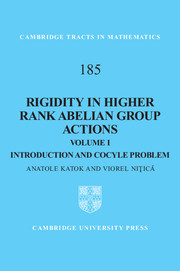Book contents
4 - First cohomology and rigidity for vector-valued cocycles
from Part II - Cocycles, cohomology, and rigidity
Published online by Cambridge University Press: 05 July 2011
Summary
Cocycles over general group actions: an overview
The relevance of cocycles for dynamical systems questions
In this chapter we study the first cohomology of a group action. Higher order cohomology will be discussed in Chapter 6. First cohomology comes in two flavors: ordinary (or untwisted) and twisted. Most of the chapter deals with ordinary cohomology, which has been extensively studied and for which a more developed theory is available. The twisted version is discussed in Section 4.6.
Cohomology is an equivalence relation on a class of functions called cocycles. Cocycles lie at the center of many questions about the rigidity of various smooth actions, existence of invariant structures, and other important properties of the action. A cocycle over a group action allows for a lift of the action in the base to an extended action of a fibered space. Information about the extended action is used for analyzing the action in the base. Another direction is to use this construction in order to built new examples of actions of fibered spaces that inherit the properties that we have in the base. More generally, one can consider extensions to principal bundles. We refer to Section 1.4, Section 5.1, and Section 5.4.4 for more details about extensions to principal bundles.
- Type
- Chapter
- Information
- Rigidity in Higher Rank Abelian Group Actions , pp. 133 - 201Publisher: Cambridge University PressPrint publication year: 2011



